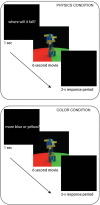Precise functional connections between the dorsal anterior cingulate cortex and areas recruited for physical inference
- PMID: 35441423
- PMCID: PMC9544738
- DOI: 10.1111/ejn.15670
Precise functional connections between the dorsal anterior cingulate cortex and areas recruited for physical inference
Abstract
Recent work has identified brain areas that are engaged when people predict how the physical behaviour of the world will unfold-an ability termed intuitive physics. Among the many unanswered questions about the neural mechanisms of intuitive physics is where the key inputs come from: Which brain regions connect up with intuitive physics processes to regulate when and how they are engaged in service of our goals? In the present work, we targeted the dorsal anterior cingulate cortex (dACC) for study based on characteristics that make it well-positioned to regulate intuitive physics processes. The dACC is richly interconnected with frontoparietal regions and is implicated in mapping contexts to actions, a process that would benefit from physical predictions to indicate which action(s) would produce the desired physical outcomes. We collected resting state functional magnetic resonance imaging (MRI) data in 17 participants and used independent task-related runs to find the pattern of activity during a physical inference task in each individual participant. We found that the strongest resting state functional connections of the dACC not only aligned well with physical inference-related activity at the group level, it also mirrored individual differences in the positioning of physics-related activity across participants. Our results suggest that the dACC might be a key structure for regulating the engagement of intuitive physics processes in the brain.
Keywords: anterior cingulate cortex; functional connectivity; intuitive physics; resting-state fMRI; social reasoning.
© 2022 The Authors. European Journal of Neuroscience published by Federation of European Neuroscience Societies and John Wiley & Sons Ltd.
Conflict of interest statement
Authors report no conflict of interest.
Figures





Similar articles
-
Cognitive Effort Modulates Connectivity between Dorsal Anterior Cingulate Cortex and Task-Relevant Cortical Areas.J Neurosci. 2020 May 6;40(19):3838-3848. doi: 10.1523/JNEUROSCI.2948-19.2020. Epub 2020 Apr 9. J Neurosci. 2020. PMID: 32273486 Free PMC article.
-
Alterations in brain connectivity in three sub-regions of the anterior cingulate cortex in heroin-dependent individuals: Evidence from resting state fMRI.Neuroscience. 2015 Jan 22;284:998-1010. doi: 10.1016/j.neuroscience.2014.11.007. Epub 2014 Nov 13. Neuroscience. 2015. PMID: 25446365
-
Sulcal Pattern Variability and Dorsal Anterior Cingulate Cortex Functional Connectivity Across Adult Age.Brain Connect. 2020 Aug;10(6):267-278. doi: 10.1089/brain.2020.0751. Epub 2020 Jul 20. Brain Connect. 2020. PMID: 32567343
-
Role of the dorsal anterior cingulate cortex in obsessive-compulsive disorder: converging evidence from cognitive neuroscience and psychiatric neurosurgery.J Neurosurg. 2017 Jan;126(1):132-147. doi: 10.3171/2016.1.JNS15601. Epub 2016 Apr 1. J Neurosurg. 2017. PMID: 27035167
-
Dorsal Anterior Cingulate Cortex: A Bottom-Up View.Annu Rev Neurosci. 2016 Jul 8;39:149-70. doi: 10.1146/annurev-neuro-070815-013952. Epub 2016 Apr 18. Annu Rev Neurosci. 2016. PMID: 27090954 Free PMC article. Review.
Cited by
-
A dedicated mental resource for intuitive physics.iScience. 2023 Dec 1;27(1):108607. doi: 10.1016/j.isci.2023.108607. eCollection 2024 Jan 19. iScience. 2023. PMID: 38222113 Free PMC article.
-
What tool representation, intuitive physics, and action have in common: The brain's first-person physics engine.Cogn Neuropsychol. 2021 Oct-Dec;38(7-8):455-467. doi: 10.1080/02643294.2022.2106126. Epub 2022 Aug 22. Cogn Neuropsychol. 2021. PMID: 35994054 Free PMC article.
References
MeSH terms
LinkOut - more resources
Full Text Sources

